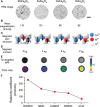Advances and prospect of nanotechnology in stem cells
- PMID: 20596412
- PMCID: PMC2894000
- DOI: 10.1007/s11671-009-9292-z
Advances and prospect of nanotechnology in stem cells
Abstract
In recent years, stem cell nanotechnology has emerged as a new exciting field. Theoretical and experimental studies of interaction between nanomaterials or nanostructures and stem cells have made great advances. The importance of nanomaterials, nanostructures, and nanotechnology to the fundamental developments in stem cells-based therapies for injuries and degenerative diseases has been recognized. In particular, the effects of structure and properties of nanomaterials on the proliferation and differentiation of stem cells have become a new interdisciplinary frontier in regeneration medicine and material science. Here we review some of the main advances in this field over the past few years, explore the application prospects, and discuss the issues, approaches and challenges, with the aim of improving application of nanotechnology in the stem cells research and development.
Keywords: Nanomaterials; Nanostructure; Nanotechnology; Regeneration medicine; Stem cells.
Figures








Similar articles
-
Nanotechnology shaping stem cell therapy: Recent advances, application, challenges, and future outlook.Biomed Pharmacother. 2021 May;137:111236. doi: 10.1016/j.biopha.2021.111236. Epub 2021 Jan 21. Biomed Pharmacother. 2021. PMID: 33486201 Review.
-
Recent advances in nanotechnology applied to biosensors.Sensors (Basel). 2009;9(2):1033-53. doi: 10.3390/s90201033. Epub 2009 Feb 17. Sensors (Basel). 2009. PMID: 22399954 Free PMC article.
-
Advance and prospect of bionanomaterials.Biotechnol Prog. 2003 May-Jun;19(3):683-92. doi: 10.1021/bp025791i. Biotechnol Prog. 2003. Retraction in: Biotechnol Prog. 2005 Mar-Apr;21(2):650. doi: 10.1021/bp0580804. PMID: 12790626 Retracted. Review.
-
Advances and prospects on biomolecules functionalized carbon nanotubes.J Nanosci Nanotechnol. 2007 Apr-May;7(4-5):1298-314. doi: 10.1166/jnn.2007.654. J Nanosci Nanotechnol. 2007. PMID: 17450892 Review.
-
Will Nanotechnology Bring New Hope for Stem Cell Therapy?Cells Tissues Organs. 2018;206(4-5):229-241. doi: 10.1159/000500517. Epub 2019 Jul 9. Cells Tissues Organs. 2018. PMID: 31288229 Review.
Cited by
-
Regression of Gastric Cancer by Systemic Injection of RNA Nanoparticles Carrying both Ligand and siRNA.Sci Rep. 2015 Jul 3;5:10726. doi: 10.1038/srep10726. Sci Rep. 2015. PMID: 26137913 Free PMC article.
-
N-containing functional groups induced superior cytocompatible and hemocompatible graphene by NH₂ ion implantation.J Mater Sci Mater Med. 2013 Dec;24(12):2741-8. doi: 10.1007/s10856-013-5016-0. Epub 2013 Aug 2. J Mater Sci Mater Med. 2013. PMID: 23907737
-
Thin-layer hydroxyapatite deposition on a nanofiber surface stimulates mesenchymal stem cell proliferation and their differentiation into osteoblasts.J Biomed Biotechnol. 2012;2012:428503. doi: 10.1155/2012/428503. Epub 2012 Jan 29. J Biomed Biotechnol. 2012. PMID: 22319242 Free PMC article.
-
Adipose Stem Cells in Regenerative Medicine: Looking Forward.Front Bioeng Biotechnol. 2022 Jan 13;9:837464. doi: 10.3389/fbioe.2021.837464. eCollection 2021. Front Bioeng Biotechnol. 2022. PMID: 35096804 Free PMC article. Review.
-
Understanding the role of biomolecular coronas in human exposure to nanomaterials.Environ Sci Nano. 2024 Sep 9;11(11):4421-4448. doi: 10.1039/d4en00488d. eCollection 2024 Nov 7. Environ Sci Nano. 2024. PMID: 39263008 Free PMC article. Review.
References
-
- Xu WR, Zhang X, Qian H, Exp. 2004. p. 623. COI number [1:CAS:528:DC%2BD2cXlslWqsLg%3D] - PubMed
LinkOut - more resources
Full Text Sources
Other Literature Sources
Miscellaneous

